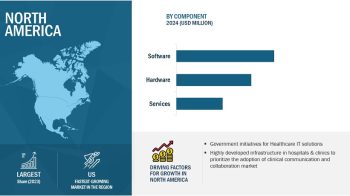Patient portals are secure websites that provide patients access to their personal health records (PHRs) and allow them to view certain information from their electronic health records (EHRs). Through these portals, patients can download information from their medical records, electronically send care/referral summaries to a third party, request a change/update to their medical record, request/schedule appointments, request prescriptions, communicate securely with providers, access lab results & other credible information, and pay bills.
Patient portals also prove beneficial for various other healthcare stakeholders (such as providers and payers) in terms of achieving administrative efficiencies.
Growth in the patient portal market is likely to be centered on the European region, due to factors such as the rising demand for advanced healthcare solutions & efficient healthcare delivery in Germany, growing focus of integrating HCIT solutions in healthcare in the U.K. & France, increasing focus of ensuring interoperability of patient health records in Italy, and increasing focus on the deployment of HER-based IT solutions in the RoE.
The German healthcare system is undergoing constant changes with respect to political regulations, rapid technological development, and steady progress in diagnostics and therapy. This has led to a growing demand from healthcare providers for new technologies for producing, managing, and archiving critical patient documents. Moreover, an increasing number of healthcare providers in Germany are resorting to value-based models for delivering healthcare services in the country. HCIT also remains a focus area to help reduce healthcare costs and medical errors. Several factors such as the fragmentation of records between different healthcare providers and soaring healthcare expenditure need to be addressed with electronic medical records. In addition, involving patients in the care delivery model and having a patient-centric healthcare delivery approach is an effective solution to enhance healthcare delivery status. This can be achieved by patient engagement solutions, like patient portals.
According to U.K. Digital Health 2015, the U.K. is currently the largest spender on telehealth solutions in Europe. Nearly 75% of the country’s population uses the Internet for health information and more than 50% uses the Internet for self-diagnosis. All these factors have triggered the growth of the IT healthcare solutions market in the U.K. Moreover, in 2014, the Commonwealth Fund rated the NHS (U.K.) as the most efficient health system out of 11 countries studied. This was majorly due to the widespread and effective use of health information technology in the U.K. healthcare system. In addition, a number of initiatives are being taken in France to implement healthcare reforms and promote the adoption of HCIT solutions to improve the operational efficiency of healthcare organizations and reduce overall healthcare expenditure. In 2012, as reported by the Embassy of France in Washington, U.S., investments worth nearly USD 6.5 billion were made in France towards the reorganization of health service locations and updating of IT systems.
Currently, various projects to promote the digitization of patient health records and increase their interoperability are being conducted in Italy. Some of these include the National Interoperability Project of Patient Summaries and Technological Infrastructure of Patient Summaries. Along with these projects, the E-Government Plan 2012 is also indirectly promoting the adoption of HCIT solutions in the country. In order to address interoperability issues among information systems of different healthcare organizations, the Italian Ministry for Public Administration and Innovation and the National Research Council of Italy have provided a model for interoperability infrastructure for EHR systems. All these initiatives are likely to fuel the adoption of patient engagement solutions in the country.
The number of EHR-based deployments in the RoE has increased over the years. Most countries in this region have already adopted or are adopting various HCIT solutions, owing to state guidelines and recommendations for the development of national HCIT infrastructure. The growing need to improve clinical outcomes of healthcare systems and reduce waiting times in hospitals, coupled with the rising number of initiatives to improve care coordination among healthcare providers, are some key factors contributing to the growth of the RoE patient portal market during the forecast period.

